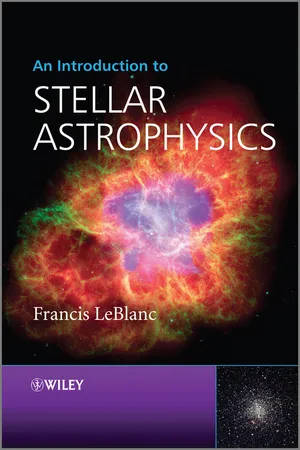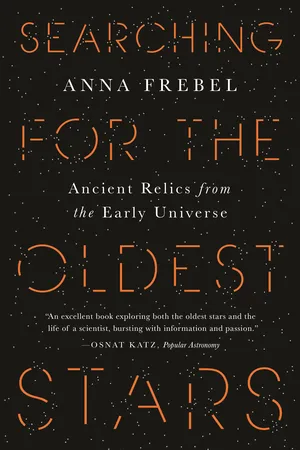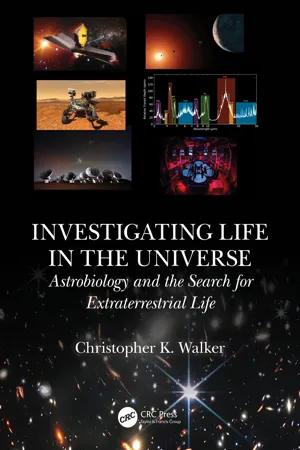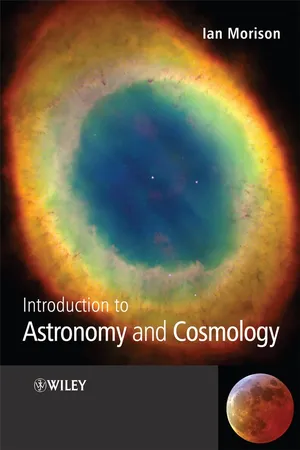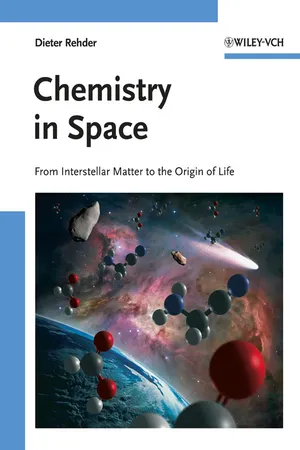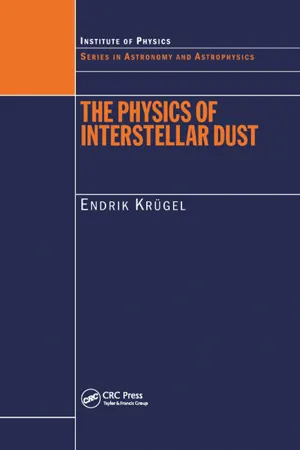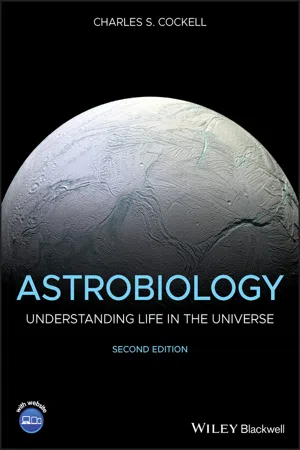Physics
The Life Cycle of a Star
The life cycle of a star begins with the formation of a protostar from a cloud of gas and dust. As the protostar accumulates mass, it enters the main sequence phase where it fuses hydrogen into helium. Depending on its mass, a star may then evolve into a red giant, shed its outer layers, and eventually end its life as a white dwarf, neutron star, or black hole.
Written by Perlego with AI-assistance
Related key terms
Related key terms
1 of 4
Related key terms
1 of 3
9 Key excerpts on "The Life Cycle of a Star"
- eBook - ePub
Astronomy
A Self-Teaching Guide, Eighth Edition
- Dinah L. Moché(Author)
- 2014(Publication Date)
- Trade Paper Press(Publisher)
To every thing there is a season, and a time to every purpose under the heaven. A time to be born, and a time to die. Ecclesiastes 3:1–25 STELLAR EVOLUTION
Objectives
Define stellar evolution.List the stages in The Life Cycle of a Star like our Sun according to the modern theory of stellar evolution.Explain the importance of the H–R diagram to theories of stellar evolution.Explain the relation between a star’s age and its position on the H–R diagram.List the main steps in the birth of a star.Describe the energy balance and pressure balance in main sequence stars.Compare and contrast what happens in the advanced stages of evolution for stars of large and small mass: planetary nebulas, white dwarfs, supernovas, pulsars/neutron stars, and black holes.Identify nebulas, main sequence, blue giant, red giant, and pulsating variable stars that can be observed in the sky.Explain how supernovas and pulsars are observed.Describe the origins of the different chemical elements and the importance of supernovas to new generations of stars.Describe observational evidence for black holes.5.1 LIFE CYCLE OF STARS
No star shines forever. Stellar evolution refers to the changes that take place in stars as they age—the life cycle of stars. These changes cannot be observed directly, because they take place over millions or billions of years. Astro nomers construct a theory of stellar evolution that is consistent with the laws of physics. Then they check their theory by observing real stars shining in the sky.In checking theory against observations, astronomers make use of H–R diagrams. Theoretical predictions are made regarding a sequence of changes in luminosity and temperature for stars as they go from birth to death. These changes are plotted on an H–R diagram, forming theoretical tracks of evolution . Theoretical H–R diagrams are then compared with H–R diagrams for groups of real stars (Section 6.4 - eBook - ePub
- Francis LeBlanc(Author)
- 2011(Publication Date)
- Wiley(Publisher)
Another possible energy source in stars is chemical energy. However, it is also easy to show (see Exercise 6.1) that energy coming from chemical reactions in stars is not sufficient to solve the energy problem for stars.Another energy source must then be present. It wasn ’t until the beginning of the twentieth century that it was understood that the energy source responsible for the great luminosities of stars was nuclear in nature.As mentioned previously in this book, a star begins its life by burning (or fusing) hydrogen in its core. As hydrogen is transformed into helium, the structure of the star readjusts. When all of the hydrogen in the stellar core is spent, the star evolves relatively rapidly. As will be seen later in this chapter, the star then evolves to other stages such as the red - giant phase, and depending on its mass, it will be able to burn (or fuse) heavier nuclei as time progresses. This process leads to the production of the various elements found in the Universe and is commonly called nucleosynthesis.1 Nuclear burning is therefore an essential ingredient to understand how stars evolve.In this chapter, the physics surrounding thermonuclear (or fusion) reactions and the energy they emit as well as their relation to the evolution of stars will be discussed. An optional section concerning nuclear models will be presented for the reader who wishes more information on the underlying physics behind nuclear fusion. For an even deeper understanding of nuclear fusion, an optional advanced section is also presented at the end of this chapter that discusses nuclear reaction cross sections and rates.The various nuclear reactions taking place on the main sequence and at later evolutionary stages will be given. Examples of evolutionary tracks of stars in the H–R diagram will be shown. The relation of stellar evolution to stellar clusters, galaxies and stellar populations will then be described. The properties of the end states of stars, namely white dwarfs, neutron stars and black holes will be presented. The processes by which the elements heavier than iron are formed as well as the properties of novae and supernovae will also be discussed. However, before seeing these topics, general properties of thermonuclear reactions will be described. - eBook - ePub
Searching for the Oldest Stars
Ancient Relics from the Early Universe
- Anna Frebel(Author)
- 2015(Publication Date)
- Princeton University Press(Publisher)
CHAPTER 4 STELLAR EVOLUTION—FROM BIRTH TO DEATHOn a clear night a few thousand stars are visible to the naked eye. The celestial sky is thus like a photograph of a big crowd of people. We are dealing with a cross-section of an entire population and much can be learned about the characteristics of humans—or stars—from such an image. Just like we people are born as babies, grow up as children and teenagers, and later die as old and experienced adults, all stars go through a cosmic life cycle of their own consisting of a number of stages.By observing different kinds of stars, it is possible to gain clues about their nature and this life cycle. It becomes evident that the different stages of stellar evolution are closely connected to the various processes of nuclear fusion occurring in their inner regions. Keeping this in mind, we can now examine the evolution of stars in greater detail, from their births to their gigantic supernova explosions.4.1 Sorting StarsAt first glance, a crowd of people looks messy and unstructured. But with a few little tricks the apparent jumble can be sorted to gain some order. For example, all the participants can be grouped by the color of their shirts. Or else, a group of people can be divided by body height, age, or gender. Important conclusions about the group as a whole can be drawn from this information. Sorting stars is very similar. Surface temperature, luminosity, and chemical composition are the characteristic features. With knowledge of these three properties, it is possible to classify stars because they describe basic details about their nature.Figure 4.1. The Hertzsprung-Russell diagram for stars in the vicinity of the Sun. The different branches and regions are easily recognizable. (Source - eBook - ePub
Investigating Life in the Universe
Astrobiology and the Search for Extraterrestrial Life
- Christopher K. Walker(Author)
- 2023(Publication Date)
- CRC Press(Publisher)
In this chapter, we have investigated how humankind used observations of the night sky, together with deductive reasoning and experiment, to understand the true nature of stars. Without stars, there would be no heavy elements for planets or a steady source of energy to nurture life on planetary surfaces over the billions of years required for the emergence of intelligent life. The understanding of stellar evolution is one of humanity’s greatest achievements, and it did not come easy. It took the collective work of ~250 generations of observers, mathematicians, physicists, and technologists to gain the insights we have today. The great advances achieved in astrophysics over the last century came in the wake of technological leaps in telescopes and instrumentation, together with insights into quantum mechanics and the nature of space and time itself. We now know that it is in the vicinity of stars like our Sun that conditions will be the most conducive for harboring planets with advanced life. We also know that protoplanetary disks are a natural consequence of the star formation process. In the next chapter, we will investigate how planets form and which types are expected to be best for life.Problems
- Compute the energy of photons at wavelengths of 0.1, 1, 10, 100, and 1,000 microns.Which wavelengths correspond to UV, optical, infrared, and terahertz photons?
- At what wavelengths do F, G, K, and M stars radiate most of their photons?
- What is the gravitational force between you and the Earth? Between the Earth and the Moon?
- What is the required mass density for a 1 solar mass cloud to collapse if its average temperature is 10, 50, or 100 K? How do these densities compare to what is in your room?
- When is a star like our Sun the brightest?
- Compute the main sequence lifetime of a 0.2, 0.5, 1, 5, and 10 solar mass star.
- What percent of a star’s lifetime is spent in the protostellar phase?
- What element cannot participate in a nuclear fusion reaction? Why?
- Why do very high-mass stars go supernova?
- About how many times have the atoms in your body participated in a supernova explosion?
- If our Sun was to become a black hole (which it will not), what would be its diameter?
References
- Boltzmann, L. 1884. “Ableitung des Stefan’schen Gesetzes, Betreffend die Abhängigkeit der Wärmestrahlung von der Temperatur aus der Electromagnetischen Lichttheorie” [“Derivation of Stefan’s Law, Concerning the Dependency of Heat Radiation on Temperature, from the Electromagnetic Theory of Light.”] Annalen Der Physik & Chemie (in German)
- eBook - ePub
- Ian Morison(Author)
- 2013(Publication Date)
- Wiley(Publisher)
Chapter 7Stellar Evolution – The Life and Death of Stars
We have seen how stars are formed and how our Sun burns hydrogen to helium whilst lying on the main sequence. This chapter will look at how stars in different mass ranges evolve, both on the main sequence and during the later stages of their life, and describe the remnants left when they die: white dwarfs, neutron stars and black holes. The distinction between low, mid, and high mass stars seem somewhat arbitrary in the literature, so the mass ranges have been specified in the headings to follow.7.1 Low mass stars: 0.05–0.5 solar masses
For a collapsing mass of gas to become a star, nuclear fusion has to initiate in its core. This requires a temperature of ~10 million K and this can only be reached when the contracting mass is greater than ~1029 kg, about 1/12 the mass of the Sun, or 80 times that of Jupiter.In low mass stars the conversion of hydrogen to helium by nuclear fusion is the same as in our Sun. However, in stars of greater mass nuclear fusion only converts ~10% of the mass of the star (that residing in its core), whilst in the lowest mass stars it is thought that convection currents that mix the star’s interior will allow much of the star’s mass to undergo nuclear fusion so increasing its lifetime on the main sequence – a period which is significantly longer than the present age of the universe. We thus have no direct observational evidence of what happens when fusion ceases in such stars and can only use computer modelling to investigate what might happen.We will see that in order for helium to fuse into heavier elements, temperatures of order 100 million K are required, and this requires sufficient mass in the star’s envelope to provide the required pressure to enable such temperatures to be reached. In stars of mass less than 0.5 solar masses there is simply not enough pressure to give the temperatures that would allow helium fusion to begin. Consequently, when nuclear fusion, converting hydrogen to helium, finally ceases – and modelling of a 0. 1 solar mass red dwarf suggests that this might be after 6 trillion years – the star will slowly collapse over a period of several hundred billion years to form what is called a white dwarf. Over many trillions of years, the white dwarf will cool until its surface temperature is below that at which significant light is emitted and the inert remnant will become a black dwarf . No white dwarfs derived from low mass stars yet exist, but they will be discussed in detail in the next section as their evolution also produces white dwarfs which can - eBook - ePub
Chemistry in Space
From Interstellar Matter to the Origin of Life
- Dieter Rehder(Author)
- 2011(Publication Date)
- Wiley-VCH(Publisher)
Stars of about the present mass of our Sun (F-, G-, and K-type stars), condensing out of a gas and dust nebula, start as subgiant (luminosity class IV) pre -main sequence stars, arriving at the main sequence after about 100 million years. These Sun-like stars will spend most of their lifetime on the main sequence, and finally end up as white dwarfs. For the Sun, the dwell time on the main sequence is estimated to cover another 10 billion years, in addition to the 4.6 billion years that already have elapsed. Depending on their mass, old stars will evolve through planetary nebulae or supernovae into white dwarfs, neutron stars, or black holes; for planetary nebulae (PN) and supernovae, see Figures 3.3a and b, for a white dwarf "devouring" a giant companion star, see Figure 3.3c. Figure 3.3 Examples for stars at their evolutionary end stages. (a) Cat’s Eye Nebula, a PN in the constellation of Draco. Credit: NASA, ESA; J. Hester and A. Loll (Arizona State University). (b) A recent photo of the Crab Nebula in the constellation of Taurus, a remnant of a supernova dating back to 1054. The central star is a pulsar (cf. Section 3.1.2). Credit: NASA, ESA, HEIC and the Hubble Heritage Team. (c) The nova Mira (= o Ceti), a variable binary system: a white dwarf, Mira B, drags and accretes matter from its red giant companion Mira A. Credit: NASA/CXC/SAO/M; Karovska et al. The typical stages of the development of a star of approximately the mass of the Sun are represented by tracks 1-6 of the evolution line in the HR diagram, Figure 3.2. In short, these stages are as given below: 1) Accretion of a nebula into a protostar that further develops into a T-Tauri variable and finally commences hydrogen fusion to helium (hydrogen burning) - Britannica Educational Publishing, Erik Gregersen(Authors)
- 2009(Publication Date)
- Britannica Educational Publishing(Publisher)
TAR FORMATION AND EVOLUTIONT hroughout the Milky Way Galaxy (and even near the Sun itself), astronomers have discovered stars that are well evolved or even approaching extinction, or both, as well as occasional stars that must be very young or still in the process of formation. Evolutionary effects on these stars are not negligible, even for a middle-aged star such as the Sun. More massive stars must display more spectacular effects because the rate of conversion of mass into energy is higher. While the Sun produces energy at the rate of about two ergs per gram per second, a more luminous main-sequence star can release energy at a rate some 1,000 times greater. Consequently, effects that require billions of years to be easily recognized in the Sun might occur within a few million years in highly luminous and massive stars. A supergiant star such as Antares, a bright main-sequence star such as Rigel, or even a more modest star such as Sirius cannot have endured as long as the Sun has endured. These stars must have been formed relatively recently.BIRTH OF STARS AND EVOLUTION TO THE MAIN SEQUENCE
Detailed radio maps of nearby molecular clouds reveal that they are clumpy, with regions containing a wide range of densities—from a few tens of molecules (mostly hydrogen) per cubic centimetre to more than one million. Stars form only from the densest regions, termed cloud cores, though they need not lie at the geometric centre of the cloud. Large cores (which probably contain subcondensations) up to a few light-years in size seem to give rise to unbound associations of very massive stars (called OB associations after the spectral type of their most prominent members, O and B stars) or to bound clusters of less massive stars. Whether a stellar group materializes as an association or a cluster seems to depend on the efficiency of star formation.- eBook - ePub
- Endrik Krugel(Author)
- 2002(Publication Date)
- CRC Press(Publisher)
Chapter 15Stars and their formation
To get an idea of how the elements that make up interstellar dust are created, section 15.1 deals with nulear burning, in particular, with the pp chain and the 3αprocess. We then present approximate formulae for the luminosity and lifetime of individual stars, discuss the initial mass function (IMF) which specifies how masses are distributed when stars are bom, and show averages for star clusters displaying an IMF. In section 15.2 , we delineate the structure of cloud clumps at the verge of gravitational instability and present Jeans’s criterion for collapse to actually occur. In section 15.3 , we numerically analyse the equations for spherical, isothermal collapse and derive, for the earliest stages of protostellar evolution, the approximate density and velocity structure of the protostellar clump. Section 15.4 treats disks which inevitably form as the result of cloud rotation and which have a strong effect on the appearance and dynamical evolution of protostars, to say nothing about planet formation. The results of section 15.3 and 15.4 serve as the basis for models of dust and molecular line emission in chapter 16 .15.1 Stars on and beyond the main sequence
15.1.1 Nuclear burning and the creation of elements
Stars form the most obvious component of the Milky Way. They are, by and large, the ultimate source of luminosity in galaxies. The energy is generated in the stellar cores by fusion of atomic nuclei. During the main-sequence phase, hydrogen is burnt into helium. In the post-main-sequence phase, when hydrogen has been exhausted, elements of atomic mass number greater than four are produced by compounding helium nuclei. The energy yield per gram of matter is then one order of magnitude smaller. Fusion ends with the generation of iron which has the lowest binding energy per nucleon; heavier nuclei release energy not in fusion but in fission. An example is uranium 235 - eBook - ePub
Astrobiology
Understanding Life in the Universe
- Charles S. Cockell(Author)
- 2020(Publication Date)
- Wiley-Blackwell(Publisher)
Chapter 17 , Earth will become uninhabitable long before this stage.We can now see that understanding the evolutionary trajectory of low-mass stars already gives us significant information to understand life in its cosmic context. We can grasp the power of astrophysics to yield insights into the underlying facts of biology. We now understand the origin of most of the carbon in the Universe, a critical core element for life. We now also understand the fate of low-mass stars and thus any habitable planets that might be orbiting them, an example being Earth.9.4 Stellar Evolution: High-Mass Stars
Another group of stars are the high-mass stars. These stars have a mass about eight times or more than that of the Sun. The consequence of their larger mass is that their cores contract to a much greater density and achieve higher temperatures – thus allowing fusion reactions to occur beyond the production of carbon.Schematic of the CNO cycle in high-mass (and intermediate) stars. The numbers of protons and neutrons are schematically shown.Figure 9.6In high-mass stars, hydrogen fusion to helium is dominated by a more complicated cycle called the CNO cycle (Figure 9.6 ).In the CNO cycle, carbon acts as a catalyst for the production of helium (alpha particles). One hydrogen nucleus (proton) fuses with carbon-12 (with the emission of a gamma ray) to produce nitrogen-13, which then decays to carbon-13 producing a positron and a neutrino. The carbon-13 so produced takes up yet another proton to form nitrogen-14 with a gamma ray given off. This nitrogen-14 takes up the next (third) proton to form oxygen-15 with the emission of a gamma ray, and this oxygen decays to nitrogen-15 with the production of a positron and a neutrino. Finally, this nitrogen-15 fuses with the fourth proton with the release of a helium nucleus, producing carbon-12, which can begin the cycle again. The overall effect – the fusing of four hydrogen nuclei (protons) to form one helium nucleus – is the same as the proton–proton reaction in low-mass stars.
Index pages curate the most relevant extracts from our library of academic textbooks. They’ve been created using an in-house natural language model (NLM), each adding context and meaning to key research topics.
Explore more topic indexes
Explore more topic indexes
1 of 6
Explore more topic indexes
1 of 4

